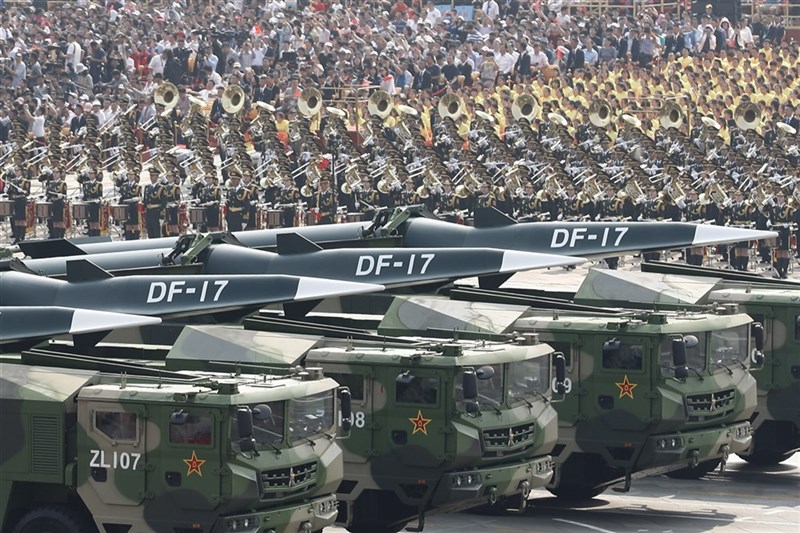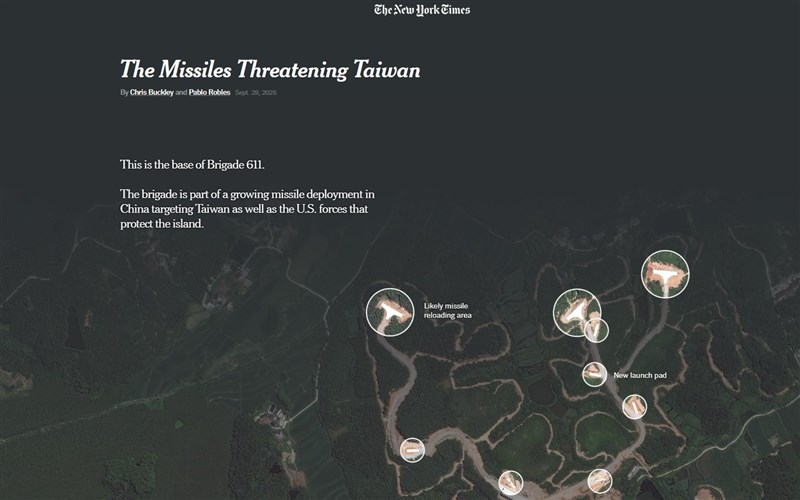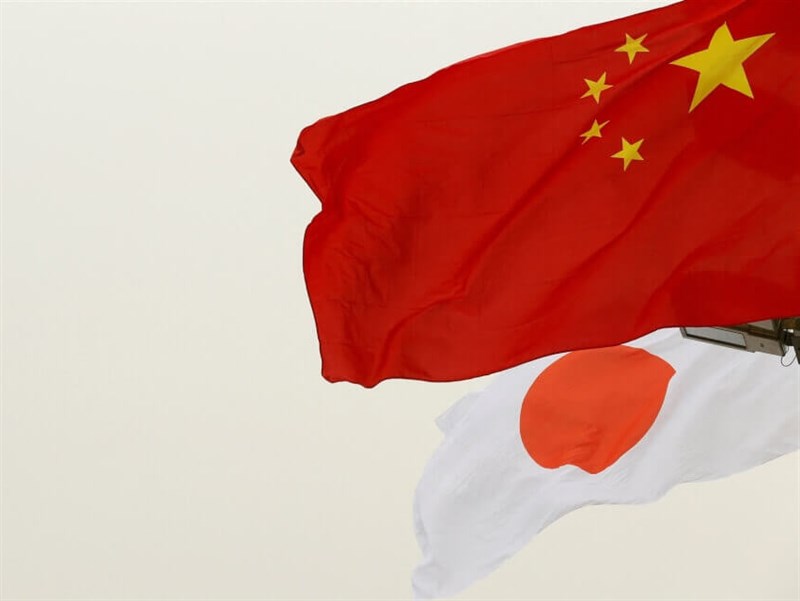ANALYSIS/China's Dongfeng-17 missile deployments a looming threat for Taiwan: Experts

Taipei, Oct. 3 (CNA) China's plan to deploy a new hypersonic ballistic missile at a People's Liberation Army Rocket Force (PLARF) base near Taiwan likely targets U.S. air bases and ships in the Western Pacific, but it will also present new threats to the island country, according to defense experts.
An article titled "The Missiles Threatening Taiwan," published Monday in the The New York Times, cited the 2024 U.S. Department of Defense report on China's military power, noting China has stockpiled 3,500 missiles, a 1.5-times increase compared with four years prior.
Although it is unclear how many of these missiles target Taiwan, the newspaper reported that the PLARF Brigade 616 base in Jiangxi Province has undergone rapid expansion since 2020 and is now being prepared for Dongfeng-17 (DF-17) hypersonic ballistic missiles, citing sources that included Derrek Eveleth, a researcher at the American think tank Center for Naval Analyses.
Dongfeng-17: a new threat

Satellite images show that China leveled farmland for the facility in 2020, about 579 kilometers from Taiwan's main island, and by 2021 it was "nearly complete," according to the Times. Images from this year show several new structures on the site, including a possible garage for mobile missile launchers.
However, the article did not explain why deploying the DF-17, with an estimated range of 1,500-2,500 kilometers, at Brigade 616 poses a threat to Taiwan.
Eric Heginbotham, a principal research scientist at MIT's Security Studies Program, said China's hypersonic missiles, such as the DF-17, are relatively long-range and therefore likely not designed to hit targets on Taiwan.
"If they have the range ascribed to them in the open source literature, then using them against Taiwan would be a suboptimal use of resources," Heginbotham told CNA.
The missile will, therefore, more likely be deployed against U.S. vessels coming to Taiwan's aid or air bases in the Western Pacific if Taiwan and China go to war, Heginbotham said.
However, he added, "To say that it is not designed or optimized to hit targets on Taiwan is not to say that it would never be used against Taiwan, regardless of circumstances."
If, for example, the United States did not intervene and/or China were running low on other types of missiles, it might use the DF-17 against Taiwan, he said, citing Russia's use of Zircon missiles against targets in Ukraine that were "not anticipated for that system."
Kao Chih-jung (高志榮), a researcher at Taiwan's Institute for National Defense and Security Research, agreed.
The DF-17 would ideally be used to strike ships and U.S. air bases in the Western Pacific, such as the Kadena Air Base in Okinawa, Kao said.
However, if China's short-range ballistic missiles, such as the DF-11 and DF-15, fail to yield a satisfactory hit rate in an assault on Taiwan, the DF-17, which relies on thrust vectoring control to evade interception, might be called up for that task, he said.
Alternatively, the DF-17 might be deployed if Taiwan manages to mount a successful defense against the first four waves of missile strikes, he added.
'Deep counterstrike'
China currently has around 1,000 short-range missiles targeting Taiwan and around 300 launchers, which translates to four waves of attacks on the island, Kao explained.
If those attacks failed to wipe out missile sites and air bases in Taiwan, China would likely launch a fifth wave of attack using the DF-17, Kao said.
Either scenario would transfer part of the missiles intended for the U.S. to an attack on Taiwan, which would in turn advantage potential U.S. intervention, allowing it to more readily advance its forces toward the Taiwan Strait, he noted.
On how Taiwan can effectively counter the PLA's missiles, Kao said the military should launch a "deep counterstrike" at China's missile bases while maintaining its defense posture.
"Otherwise, we are just wasting our air defense missiles," Kao argued.
Taiwan's land attack cruise missiles
Taiwan currently has several types of missiles capable of striking the Chinese mainland, including the Yunfeng hypersonic cruise missile, the Hsiung Feng IIE and Hsiung Sheng surface-to-surface cruise missile, and the Wan Chien air-to-ground cruise missile, all of which were developed by the government-owned weapons developer National Chung Shan Institute of Science and Technology (NCSIST), Kao said.
In addition, the NCSIST is already developing a new variant of the Chiang-Kong ("Strong Bow") surface-to-air missile unveiled last month at the Taipei Aerospace & Defense Exhibition that can also hit targets in China, Kao said, citing sources familiar with the matter.
The missile under development is said to be a surface-to-surface ballistic missile that has an estimated range of 1,000 km, Kao said.
For Taiwan to mount an effective defense, Kao stressed, it needs to "significantly enlarge" its missile arsenal to strengthen both self-defense and strike capabilities in the face of the rapid expansion of the PLARF.
He estimates that a wave of deep counterstrike would require at least 170 missiles to knock out the nine Dongfeng missile bases, three long-range rocket bases as well as the Fuzhou and Zhangzhou air bases and one of the five S300 air defense systems deployed along China's southeastern coast to create an opening for the missiles to land.
"We would need several waves of such attacks," He said.
Heginbotham also stressed the importance for Taiwan to diversify its responses to a Chinese military attack. "Taiwan cannot rely entirely on active defenses, but should also employ dispersion and hardening [of critical military assets], as well as a good mix of weapons," he said.
In response to CNA's request for comment on China's deployment of DF-17 missiles in Jiangxi, Ministry of National Defense deputy spokesperson Major General Chiao Fu-chun (喬福駿) said that the ministry is closely monitoring PLARF's deployments using its joint intelligence, surveillance and reconnaissance capabilities.
"Taiwan's military possesses early-warning systems and multi-layered air-defense capabilities to counter a range of aerial threats," Chiao said, adding "It continues to develop and refine response measures based on evolving enemy activity and actively advances countermeasures."
![Fintech expert urges NTD stablecoin to protect monetary sovereignty]() Fintech expert urges NTD stablecoin to protect monetary sovereigntyA fintech expert in Taiwan has called for the issuance of a New Taiwan dollar (NTD) stablecoin, saying it is vital for safeguarding Taiwan's monetary sovereignty and reinforcing the country's industrial competitiveness.12/14/2025 04:15 PM
Fintech expert urges NTD stablecoin to protect monetary sovereigntyA fintech expert in Taiwan has called for the issuance of a New Taiwan dollar (NTD) stablecoin, saying it is vital for safeguarding Taiwan's monetary sovereignty and reinforcing the country's industrial competitiveness.12/14/2025 04:15 PM![China-Japan diplomatic spat not what it seems: Taiwan experts]() China-Japan diplomatic spat not what it seems: Taiwan expertsJapan's first female prime minister, Sanae Takaichi, has faced rising friction with China during her first month in office, with Taiwan unexpectedly pulled into the fray.11/21/2025 06:58 PM
China-Japan diplomatic spat not what it seems: Taiwan expertsJapan's first female prime minister, Sanae Takaichi, has faced rising friction with China during her first month in office, with Taiwan unexpectedly pulled into the fray.11/21/2025 06:58 PM![China's local bounty use shows intimidation with flexibility: Scholars]() China's local bounty use shows intimidation with flexibility: ScholarsChina's recent use of local public security bureaus to issue bounty notices against specific Taiwanese individuals reflects a new tactic of "judicial intimidation" aimed at Taiwan that also gives Beijing room for flexibility, scholars told CNA.11/15/2025 04:45 PM
China's local bounty use shows intimidation with flexibility: ScholarsChina's recent use of local public security bureaus to issue bounty notices against specific Taiwanese individuals reflects a new tactic of "judicial intimidation" aimed at Taiwan that also gives Beijing room for flexibility, scholars told CNA.11/15/2025 04:45 PM
- Sports
Fireballer Hsu Jo-hsi joins NPB champions SoftBank Hawks on 3-year deal
12/26/2025 01:50 PM - Society
- Business
U.S. dollar lower in Taipei trading
12/26/2025 11:43 AM - Society
Taiwan headline news
12/26/2025 10:12 AM - Society
Continental cold air mass brings snowfall to Yushan
12/26/2025 09:53 AM


